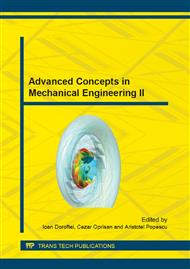[1]
L.C. Gilbert, The functional food trend: What's next and what American think about eggs. Journal of the American College of Nutrition, 19 (2000) 507S–512S.
DOI: 10.1080/07315724.2000.10718973
Google Scholar
[2]
P. Ragaert, W. Verbeke, F. Devlieghere, J. Debevere, Consumer perception and choice of minimally processed vegetables and packaged fruits. Food Quality and Preference 15 (2004) 259–270.
DOI: 10.1016/s0950-3293(03)00066-1
Google Scholar
[3]
W. Jongen, Introduction. In W. Jongen (Ed. ), Fruit and vegetable processing. Cambridge, UK/Boca Raton, FL: Wood-head Publishing Limited/CRC Press LLC, (2002).
Google Scholar
[4]
A. Allende, A. Francisco, T. Barbera´n, I. M. Gil, Minimal processing for healthy traditional foods. Trends in Food Science & Technology 17 (2006) 513–519.
DOI: 10.1016/j.tifs.2006.04.005
Google Scholar
[5]
C. Manvell, Minimal processing of food. Food Science and Technology Today 11 (1997) 107–111.
Google Scholar
[6]
A.A. Kader, Quality parameters of fresh-cut fruit and vegetable products. In O. Lamikanra (Ed. ), Fresh-cut fruits and vegetables, (2002).
DOI: 10.1201/9781420031874.ch2
Google Scholar
[7]
D. Rico, A.B. Martin-Diana, J. Henehan, J.M. Frias, G.T.M. Barat, C. Barry-Ryan, Improvement in texture using calcium lactate and heat-shock treatments for stored ready-to-eat carrots. Journal of Food Engineering 79 (2006) 1196 – 1206.
DOI: 10.1016/j.jfoodeng.2006.04.032
Google Scholar
[8]
D. Rico, A.B. Martı´n-Diana, J.M. Barat, C. Barry-Ryan, Extending and measuring the quality of fresh-cut fruit and vegetables: a review. Trends in Food Science & Technology 18 (2007) 373 – 386.
DOI: 10.1016/j.tifs.2007.03.011
Google Scholar
[9]
S.J. Kays, Preharvest factors affecting appearance. Postharvest Biology and Technology 15 (1999) 233 - 247.
DOI: 10.1016/s0925-5214(98)00088-x
Google Scholar
[10]
F.M. Clydesdale, Color as a factor in food choice. Critical Reviews in Food Science and Nutrition 33: 1 (1993) 83 - 101.
DOI: 10.1080/10408399309527614
Google Scholar
[11]
T. Brown, S.J. James, G. Purnell, M.J. Swain, Improving food cutting systems, In Proceedings of IChemE Food and Drink (2000) 103–106.
Google Scholar
[12]
T. Brown, J.S. James, L.G. Purnell, Cutting forces in foods: experimental measurements. Journal of Food Engineering 70: 2 (2005) 165–170.
DOI: 10.1016/j.jfoodeng.2004.09.022
Google Scholar
[13]
E. Laurila, R. Ahvenainen, Minimal processing of fresh fruits and vegetables. In W. Jongen (Ed. ), Fruit and vegetable processing. Cambridge, UK/Boca Raton, FL: Woodhead Pub-lishing Limited/CRC Press LLC, (2002).
DOI: 10.1533/9781855736641.3.288
Google Scholar
[14]
AR-USDA, Fresh-cut fruit moves into the fast lane. Agricultural Research Magazine 8 (2005) 53.
Google Scholar
[15]
G.M. Sapers, Washing and sanitizing raw materials for minimally processed fruit and vegetable products. In J. S. Novak, G. M. Sapers, & V. K. Juneja (Eds. ), Microbial safety of minimally processed foods. Boca Raton, FL: CRC Press LLC, 2003, p.222.
DOI: 10.1201/9781420031850.ch11
Google Scholar
[16]
V. Nedeff, Procese de lucru, masini si instalatii pentru industria alimentara, Editura Agris, Redactia Revistelor Agricole, Bucuresti, (1997).
Google Scholar
[17]
M. Panainte, E. Mosneguţu, C. Savin, V. Nedeff, Echipamente de proces în industria alimentara. Maruntirea produselor agroalimentare, Editura Meronia si Rovimed Publishers, (2005).
Google Scholar
[18]
M.D. Alvarez, D.E.J. Saunders, J.F.V. Vincent, Jeronimidis G., An engineering method to evaluate the crisp texture of fruit and vegetables, Journal of Texture Studies 4 (2000) 457–473.
DOI: 10.1111/j.1745-4603.2000.tb00302.x
Google Scholar
[19]
T. Atkins, Food and Food-Cutting Devices and Wire Cutting. The Science and Engineering of Cutting (2009) 849–860.
DOI: 10.1016/b978-0-7506-8531-3.00012-2
Google Scholar
[20]
S.M. Goh, M.N. Charalambides, J.G. Williams, On the mechanics of wire cutting of cheese, Engineering Fracture Mechanics 72: 6 (2005) 931–946.
DOI: 10.1016/j.engfracmech.2004.07.015
Google Scholar
[21]
P. Fellows, Food processing technology. Principles and practice, Second Edition, Woodhead Publishing Limited, England, (2000).
Google Scholar
[22]
T. Raven, The future of texture analysis, International Food Ingredients 1 (1998) 42-44.
Google Scholar
[23]
I. Shmulevich, Nondestructive texture assessment of fruits and vegetables, Acta Horticulturae, 599 (2003) 289–296.
DOI: 10.17660/actahortic.2003.599.34
Google Scholar
[24]
M. Panainte, Cercetări privind optimizarea procesului de maruntire a produselor agroalimentare, PhD Thesis, Gheorghe Asachi, Technical University of Iasi, (2008).
Google Scholar
[25]
M.A. Toivonen Peter, A. Brummell David, Biochemical bases of appearance and texture changes in fresh-cut fruit and vegetables. Postharvest Biology and Technology 48 (2008) 1–14.
DOI: 10.1016/j.postharvbio.2007.09.004
Google Scholar
[26]
M. Cantwell, T. Suslow, Postharvest handling systems: minimally processed fruits and vegetables. In: Kader, A.A. (Ed. ), Postharvest Technology of Horticultural Crops, 3311 3rd Ed. Univ California Special Publ., 2002, p.445–463.
Google Scholar
[27]
M.K. Deza-Durand, M.A. Petersen, The effect of cutting direction on aroma compounds and respiration rate of fresh-cut iceberg lettuce (Lactuca sativa L. ). Postharvest Biology and Technology, 61 (2011) 83–90.
DOI: 10.1016/j.postharvbio.2011.02.011
Google Scholar
[28]
Sandhya, Modified atmosphere packaging of fresh produce: Current status and future needs. LWT - Food Science and Technology 43 (2010) 381–392.
DOI: 10.1016/j.lwt.2009.05.018
Google Scholar
[29]
I. Kamyab, S. Chakrabarti, J.G. Williams, Cutting cheese with wire. Journal of Material Science (1998) 63–70.
Google Scholar
[30]
C. Olaru, Contribuţii la studiul regimului de mărunţire a materialelor agroalimentare cu textură moale, Teză de doctorat, Universitatea Vasile Alecsandri, din Bacău, (2012).
Google Scholar


